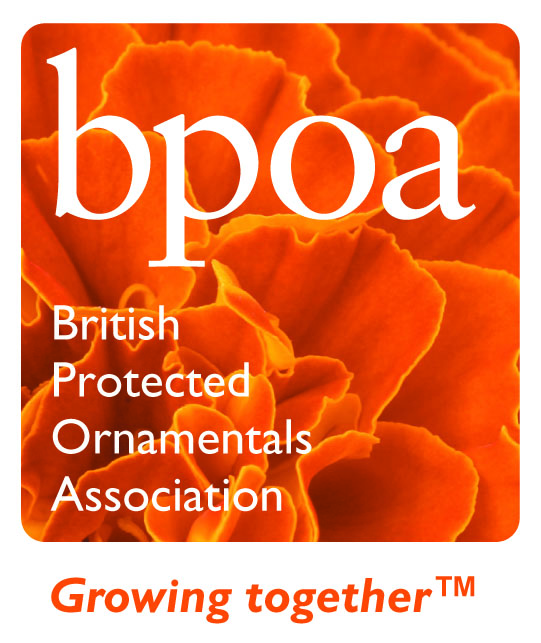Latest activities
Since receiving the Peter Seabrook Foundation/ BOA scholarship I have completed my Level 5 Commercial Horticulture studies, achieving an average grade above 70% for the academic year. I am now looking forward to beginning Level 6, with the opportunity to focus on a research project that will allow me to utilise practical and theoretical skills developed over Levels 4 and 5. An aspect of my Level 5 studies included an industry placement period; for this, I was given the opportunity to work as a nursery and retail assistant at Merriments Gardens in East Sussex.

I continued in this nursery role beyond the academic year, assisting with numerous aspects of ornamental and edible nursery production. I was working predominantly in protected environments, including heated polytunnels and glasshouses. I was largely responsible for sowing, transplanting and merchandising fruit and vegetable plants, following the assembly of a new propagation tunnel. As part of the construction of this tunnel, I was responsible for assembling the automated irrigation (misting) system.
Placement- Isles of Scilly
At the beginning of June, I travelled to the Isles of Scilly to complete a two-month work placement at Scilly Flowers, a cut flower nursery on St Martins producing scented Pinks (Dianthus spp.) and scented daffodils (Narcissus spp). My main role would be to assist with picking the flower stems, before they are sorted, graded, packed, and distributed in-house (directly to retail customers). The flowers are grown in polytunnels, providing a warmer, drier environment; whilst creating an even diffusion of light to encourage upright stems (Figure 1).

Pinks production
The Pinks are grown using a simple hydroponic system, with tubs of coarsely chipped coir acting as a substrate for the plants which are assembled in rows. An automated system fertigates the plants through T-Tape drip irrigation. From the end of spring into autumn, the farm harvests both 1st and 2nd year plants with these rotated on a 2-year cycle, many days harvesting close to 30,000 stems.
Narcissus cut flower management
When picking is complete, my team was responsible for maintenance of the Pinks and the tunnels to minimise pest and disease presence to improve the ease of picking. Other responsibilities include preparation of daffodil fields for the winter season; through the addition of polythene and smoke (Figure 2). The intention was to encourage earlier shoot initiation (Imanishi, 1983) resulting in an earlier crop. Alongside cut flower production, the farm also owns a beef herd used to graze pasture and the more remote land around the island. As part of my position, I have assisted with the maintenance of this herd as well as machinery operation and general maintenance of the grounds around the farm.
This placement has provided the opportunity for me to experience a largely self-contained operation featuring intensive growing systems, postharvest technology, and logistics. These operations are all occurring in a unique environment, with the farm required to negotiate the variable conditions and logistical challenges associated with being on a small island. The role has been demanding, testing my competence, adaptability, and time-management. In addition, testing my horticultural skills including identification of pests and disease. This season has seen the largest harvest of Pinks in the farm’s history and it has been exceptionally rewarding to be part of this.
Links
Merriments Gardens: https://www.merriments.co.uk/
Scilly Flowers: https://www.scillyflowers.co.uk/
Scholarship funds
The funds that have been incredibly kindly provided by the BOA and Peter Seabrook Foundation have allowed me to make my goal of a seasonal placement this summer a reality. I believed that utilising this summer by obtaining a position such as this would be a great opportunity to explore the industry further, as well as gaining additional practical and soft skills that would be invaluable when continuing my horticultural career. This position has also given me an insight into an area of protected ornamental crop production that I had not yet had the opportunity to explore, as well as new potential career opportunities.
The funds assisted with the cost of travel to the Isles of Scilly, which included travel by rail, underground, and sea. Without this financial support, I believe I would have struggled to afford this trip. The funds have also been used to cover general living costs before and during my placement. Following this placement, I plan to use the funds to assist with travel and resource costs when the new academic year begins in September, and I am certain that this financial assistance will enrich these final year studies.
Bibliography
Imanishi, H. (1983) ‘Effects of exposure of bulbs to smoke and ethylene on flowering of Narcissus tazetta cultivar ‘Grand Soleil d’Or’’, Scientia Horticulturae, 21(2), pp. 173-180.


